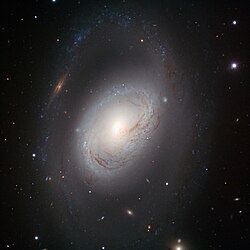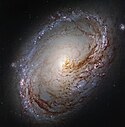Messier 96
| Messier 96 | |
 Spiralgalaxen Messier 96. Foto: ESO. | |
| Observationsdata | |
|---|---|
| Stjärnbild | Lejonet |
| Rektascension | 10t 46m 45,7s[1] |
| Deklination | +11° 49′ 12″[1] |
| Rödförskjutning | 897 ± 4[1] km/s |
| Avstånd | 31± 3 miljoner (9,6 ± 1,0 Mpc) [2] ljusår |
| Typ | SAB(rs)ab[1] |
| Skenbar storlek | 7,6× 5,2[1] bågsekunder |
| Skenbar magnitud | +10,1[1] |
| Upptäckt | |
| Upptäcktsår | 20 mars 1781 |
| Upptäckare | Pierre Méchain |
| Andra beteckningar | |
| NGC 3368, UGC 5882, PGC 32192, CGCG 66-13, MCG +02-28-006, IRAS 10441+1205, GC 2194, h 749[1] | |
| Se även: Galaxer, Lista över galaxer | |
Messier 96 (M96) även känd som NGC 3368, är en spiralgalax i stjärnbilden Lejonet på ett avstånd av ca 31 miljoner ljusår från solsystemet.[2] Den upptäcktes 1781 av Pierre Méchain och infördes fyra dagar senare av Charles Messier som nummer 96 i dennes katalog. M96 ingår i M96-hopen och är dess mest ljusstarka galax.
Observation och utseende
För att erhålla en idealisk minsta upplösning, vid god seeing, behövs åtminstone ett 10-tums teleskop, för att utskilja dess halo på 3 x 5 bågminuter med dess ljusare kärnregion.[3] Denna komplexa galax lutar med en vinkel av ca 53° mot siktlinjen från jorden och är orienterad i en positionsvinkel på 172°.
Egenskaper
Messier 96 kategoriseras som en dubbelstavig spiralgalax med en liten inre bulb genom kärnan tillsammans med en yttre bulb. Kärnan visar en svag aktivitetsnivå av typen LINER2. Variationer i ultraviolett strålning från kärnan tyder på närvaro av ett supermassivt svart hål. Uppskattningarna av detta objekts massa varierar från 1,5×106 till 4,8×107 solmassor.[4]
Den 9 maj 1998 observerades en supernova av typ Ia[5] i galaxen, registrerad som SN 1998bu. Den nådde maximal ljusstyrka den 21 maj och har därefter stadigt minskat i magnitud. Observationer av utstrålning ett år senare påvisade skapandet av 0,4 solmassor av järn. Spektrumet av supernovaresterna bekräftade förekomsten av det radioaktiva 56Co, som sönderfaller till 56Fe.[6]
Messier 96 är ungefär lika stor som Vintergatan. Den är en mycket asymmetrisk galax, som har stoft och gas ojämnt spridda över dess glesa spiralarmar, och dess kärna kompenseras bara från de inre delarna av dess ytterområden. Dess armar är också asymmetriska och tros ha påverkats av gravitationskraften hos andra galaxer inom gruppen.
Messier 96 studeras som en del av en undersökning av 50 närliggande galaxer kallad Legacy ExtraGalactic UV Survey (LEGUS),[7] som ger en oöverträffad bild av stjärnbildning inom den lokala delen av universum.
M96-gruppen
Messier 96 är den ljusaste galaxen inom M96-gruppen, en grupp galaxer i Lejonet, vars andra Messierobjekt är M95 och M105. Till detta läggs minst nio andra galaxer.[8][9][10][11] Den är den närmaste gruppen inom Lokala gruppen med kombination av ljusstarka spiralgalaxer och en ljusstark elliptisk galax (Messier 105).[12]
Galleri
- (c) ESA/Hubble, CC BY 4.0Messier 96, NASA/ESA med Hubbleteleskopet, 4 september 2015[12]
- Messier 96 med amatörteleskop
Referenser
- Den här artikeln är helt eller delvis baserad på material från engelskspråkiga Wikipedia, 17 maj 2021.
Noter
- ^ [a b c d e f g] ”NASA/IPAC Extragalactic Database”, Results for NGC 3368, http://nedwww.ipac.caltech.edu/, läst 24 oktober 2006.
- ^ [a b] Jensen, Joseph B.; Tonry, John L.; Barris, Brian J.; Thompson, Rodger I.; Liu, Michael C.; Rieke, Marcia J.; Ajhar, Edward A.; Blakeslee, John P. (2003), ”Measuring Distances and Probing the Unresolved Stellar Populations of Galaxies Using Infrared Surface Brightness Fluctuations”, Astrophysical Journal 583 (2): 712–726, doi:, Bibcode: 2003ApJ...583..712J.
- ^ Thompson, Robert Bruce; Thompson, Barbara Fritchman (2007), Illustrated Guide to Astronomical Wonders, Diy Science, O'Reilly Media, Inc., s. 283, ISBN 978-0-596-52685-6, https://books.google.com/books?id=ymt9nj_uPhwC&pg=PA283.
- ^ Nowak, N.; Thomas, J.; Erwin, P.; Saglia, R. P.; Bender, R.; Davies, R. I. (April 2010), ”Do black hole masses scale with classical bulge luminosities only? The case of the two composite pseudo-bulge galaxies NGC 3368 and NGC 3489”, Monthly Notices of the Royal Astronomical Society 403 (2): 646–672, doi:, Bibcode: 2010MNRAS.403..646N.
- ^ Meikle, P.; Hernandez, M. (2000), ”Infrared and optical study of the type Ia SN 1998bu in M96”, Memorie della Societa Astronomica Italiana 71 (2): 299–306, Bibcode: 2000MmSAI..71..299M.
- ^ Spyromilio, J.; Gilmozzi, R.; Sollerman, J.; Leibundgut, B.; Fransson, C.; Cuby, J.-G. (November 2004), ”Optical and near infrared observations of SN 1998bu”, Astronomy and Astrophysics 426 (2): 547–553, doi:, Bibcode: 2004A&A...426..547S.
- ^ ”Legacy ExtraGalactic UV Survey (LEGUS site)”. website. https://legus.stsci.edu//.
- ^ Nearby Galaxies Catalog, Cambridge University Press, 1988, ISBN 978-0-521-35299-4.
- ^ Fouque, P.; Gourgoulhon, E.; Chamaraux, P.; Paturel, G. (1992), ”Groups of galaxies within 80 Mpc. II – The catalogue of groups and group members”, Astronomy and Astrophysics Supplement 93: 211–233, Bibcode: 1992A&AS...93..211F.
- ^ Garcia, A. (1993), ”General study of group membership. II – Determination of nearby groups”, Astronomy and Astrophysics Supplement 100: 47–90, Bibcode: 1993A&AS..100...47G.
- ^ Pisani, A.; Marinoni, Christian; Ceriani, Lorenzo; Pisani, Armando (2000), ”Nearby Optical Galaxies: Selection of the Sample and Identification of Groups”, Astrophysical Journal 543 (1): 178–194, doi:, Bibcode: 2000ApJ...543..178G.
- ^ [a b] ”Hubble Peers into a Galactic Maelstrom”. Hubble Peers into a Galactic Maelstrom. 2015-09-04. http://www.nasa.gov/image-feature/goddard/hubble-peers-into-the-heart-of-a-galactic-maelstrom.
Externa länkar
 Wikimedia Commons har media som rör Messier 96.
Wikimedia Commons har media som rör Messier 96.- NOAO: M96
- SEDS: Spiral Galaxy M96
- Gray, Meghan. ”M96 – Spiral Galaxy”. Deep Sky Videos. Brady Haran. http://www.deepskyvideos.com/videos/messier/M96.html.
| ||||||||
Media som används på denna webbplats
(c) ESA/Hubble, CC BY 4.0
This new NASA/ESA Hubble Space Telescope shows Messier 96, a spiral galaxy just over 35 million light-years away in the constellation of Leo (The Lion). It is of about the same mass and size as the Milky Way. It was first discovered by astronomer Pierre Méchain in 1781, and added to Charles Messier’s famous catalogue of astronomical objects just four days later.
The galaxy resembles a giant maelstrom of glowing gas, rippled with dark dust that swirls inwards towards the nucleus. Messier 96 is a very asymmetric galaxy; its dust and gas is unevenly spread throughout its weak spiral arms, and its core is not exactly at the galactic centre. Its arms are also asymmetrical, thought to have been influenced by the gravitational pull of other galaxies within the same group as Messier 96.
This group, named the M96 Group, also includes the bright galaxies Messier 105 and Messier 95, as well as a number of smaller and fainter galaxies. It is the nearest group containing both bright spirals and a bright elliptical galaxy (Messier 105).Författare/Upphovsman: Hewholooks, Licens: CC BY-SA 3.0
Messier 96 in Leo with Amateur Telescope
Författare/Upphovsman: ESO/Oleg Maliy, Licens: CC BY 3.0
Not all spiral galaxies have to be picture-perfect to be striking. Messier 96, also known as NGC 3368, is a case in point: its core is displaced from the centre, its gas and dust are distributed asymmetrically and its spiral arms are ill-defined. But this portrait, taken with the FORS1 instrument on ESO’s Very Large Telescope, shows that imperfection is beauty in Messier 96. The galaxy's core is compact but glowing, and the dark dust lanes around it move in a delicate swirl towards the nucleus. And the spiral arms, patchy rings of young blue stars, are like necklaces of blue pearls.
Messier 96 lies in the constellation of Leo (The Lion). It is the largest galaxy in the Leo I group of galaxies; including its outermost spiral arms, it spans some 100 000 light-years in diameter — about the size of our Milky Way. Its graceful imperfections likely result from the gravitational pull of other members in the group, or are perhaps due to past galactic encounters.
A multitude of background galaxies peers through the dusty spiral. Perhaps the most striking of these objects is an edge-on galaxy that — because of a chance alignment — appears to interrupt the outermost spiral arm to the upper left of Messier 96's core.
This image was processed by ESO using the observational data found by Oleg Maliy from Ukraine, who participated in ESO's Hidden Treasures 2010 astrophotography competition [1], organised in October–November 2010, for everyone who enjoys making beautiful images of the night sky using astronomical data obtained with professional telescopes. The image was made with data taken at visible and infrared wavelengths through B, V, and I filters.
Notes
[1] ESO’s Hidden Treasures 2010 competition gave amateur astronomers the opportunity to search through ESO’s vast archives of astronomical data, hoping to find a well-hidden gem that needed polishing by the entrants. To find out more about Hidden Treasures, visit http://www.eso.org/public/outreach/hiddentreasures/.![Messier 96, NASA/ESA med Hubbleteleskopet, 4 september 2015[12]](http://upload.wikimedia.org/wikipedia/commons/thumb/f/f5/A_galactic_maelstrom.jpg/147px-A_galactic_maelstrom.jpg)




